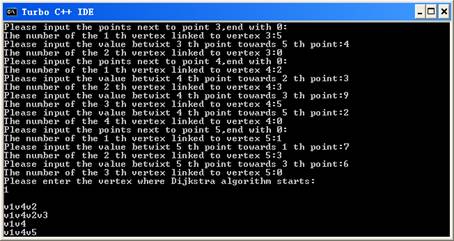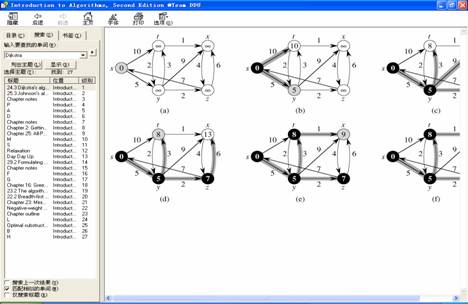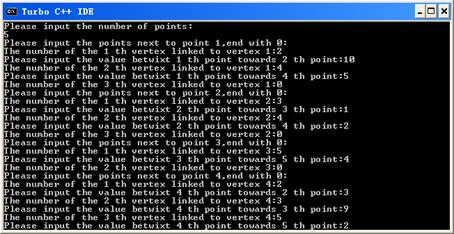Dijkstra算法
Dijkstra算法用于路由协议挺不错的,转来参考下
Dijkstra算法是典型最短路算法,用于计算一个节点到其他所有节点的最短路径。主要特点是以起始点为中心向外层层扩展,直到扩展到终点为止。Dijkstra算法能得出最短路径的最优解,但由于它遍历计算的节点很多,所以效率低。
Dijkstra算法是很有代表性的最短路算法,在很多专业课程中都作为基本内容有详细的介绍,如数据结构,图论,运筹学等等。
Dijkstra一般的表述通常有两种方式,一种用永久和临时标号方式,一种是用OPEN, CLOSE表方式,Drew为了和下面要介绍的 A* 算法和 D* 算法表述一致,这里均采用OPEN,CLOSE表的方式。
Dijkstra算法-大概过程
创建两个表,OPEN, CLOSE。
OPEN表保存所有已生成而未考察的节点,CLOSED表中记录已访问过的节点。
1. 访问路网中里起始点最近且没有被检查过的点,把这个点放入OPEN组中等待检查。
2. 从OPEN表中找出距起始点最近的点,找出这个点的所有子节点,把这个点放到CLOSE表中。
3. 遍历考察这个点的子节点。求出这些子节点距起始点的距离值,放子节点到OPEN表中。
4. 重复2,3,步。直到OPEN表为空,或找到目标点。
样例图:

输入时,将s,t,x,y,z五个点按照1,2,3,4,5起别名,输入格式按照下图例所示
当提示Please enter the vertex where Dijkstra algorithm starts:时输入算法的起始点
比如计算结果v1v4v2表示从点1到点2经过1,4,2为最短路径
Dijkstra算法的完整实现版本,算法的源代码
/* Dijkstra.c
Copyright (c) 2002, 2006 by tiham.com
All Rights Reserved.
*/
#include “stdio.h”
#include “malloc.h”
#define maxium 32767
#define maxver 9 /*defines the max number of vertexs which the programm can handle*/
#define OK 1
struct Point
{
char vertex[3];
struct Link *work;
struct Point *next;
};
struct Link
{
char vertex[3];
int value;
struct Link *next;
};
struct Table /*the workbannch of the algorithm*/
{
int cost;
int Known;
char vertex[3];
char path[3];
struct Table *next;
};
int Dijkstra(struct Point *,struct Table *);
int PrintTable(int,struct Table *);
int PrintPath(int,struct Table *,struct Table *);
struct Table * CreateTable(int,int);
struct Point * FindSmallest(struct Table *,struct Point *);/*Find the vertex which has the smallest value reside in the table*/
int main()
{
int i,j,num,temp,val;
char c;
struct Point *poinpre,*poinhead,*poin;
struct Link *linpre,*linhead,*lin;
struct Table *tabhead;
poinpre=poinhead=poin=(struct Point *)malloc(sizeof(struct Point));
poin->next=NULL;
poin->work=NULL;
restart:
printf(“Notice:if you wanna to input a vertex,you must use the format of number!\n”);
printf(“Please input the number of points:\n”);
scanf(“%d”,&num);
if(num>maxver||num<1||num%1!=0)
{
printf(“\nNumber of points exception!”);
goto restart;
}
for(i=0;i<num;i++)
{
printf(“Please input the points next to point %d,end with 0:\n”,i+1);
poin=(struct Point *)malloc(sizeof(struct Point));
poinpre->next=poin;
poin->vertex[0]=’v’;
poin->vertex[1]=’0’+i+1;
poin->vertex[2]=’\0′;
poin->work=(struct Link *)malloc(sizeof(struct Link));
linpre=lin=poin->work;
linpre->next=NULL;
for(j=0;j<num-1;j++)
{
printf(“The number of the %d th vertex linked to vertex %d:”,j+1,i+1);
scanf(“%d”,&temp);
if(temp==0)
{
lin->next=NULL;
break;
}
else
{
lin=(struct Link *)malloc(sizeof(struct Link));
linpre->next=lin;
lin->vertex[0]=’v’;
lin->vertex[1]=’0’+temp;
lin->vertex[2]=’\0′;
printf(“Please input the value betwixt %d th point towards %d th point:”,i+1,temp);
scanf(“%d”,&val);
lin->value=val;
linpre=linpre->next;
lin->next=NULL;
}
}
poinpre=poinpre->next;
poin->next=NULL;
}
printf(“Please enter the vertex where Dijkstra algorithm starts:\n”);
scanf(“%d”,&temp);
tabhead=CreateTable(temp,num);
Dijkstra(poinhead,tabhead);
PrintTable(temp,tabhead);
return OK;
}
struct Table * CreateTable(int vertex,int total)
{
struct Table *head,*pre,*p;
int i;
head=pre=p=(struct Table *)malloc(sizeof(struct Table));
p->next=NULL;
for(i=0;i<total;i++)
{
p=(struct Table *)malloc(sizeof(struct Table));
pre->next=p;
if(i+1==vertex)
{
p->vertex[0]=’v’;
p->vertex[1]=’0’+i+1;
p->vertex[2]=’\0′;
p->cost=0;
p->Known=0;
}
else
{
p->vertex[0]=’v’;
p->vertex[1]=’0’+i+1;
p->vertex[2]=’\0′;
p->cost=maxium;
p->Known=0;
}
p->next=NULL;
pre=pre->next;
}
return head;
}
int Dijkstra(struct Point *p1,struct Table *p2) /* Core of the programm*/
{
int costs;
char temp;
struct Point *poinhead=p1,*now;
struct Link *linna;
struct Table *tabhead=p2,*searc,*result;
while(1)
{
now=FindSmallest(tabhead,poinhead);
if(now==NULL)
break;
result=p2;
result=result->next;
while(result!=NULL)
{
if(result->vertex[1]==now->vertex[1])
break;
else
result=result->next;
}
linna=now->work->next;
while(linna!=NULL) /* update all the vertexs linked to the signed vertex*/
{
temp=linna->vertex[1];
searc=tabhead->next;
while(searc!=NULL)
{
if(searc->vertex[1]==temp)/*find the vertex linked to the signed vertex in the table and update*/
{
if((result->cost+linna->value)<searc->cost)
{
searc->cost=result->cost+linna->value;/*set the new value*/
searc->path[0]=’v’;
searc->path[1]=now->vertex[1];
searc->path[2]=’\0′;
}
break;
}
else
searc=searc->next;
}
linna=linna->next;
}
}
return 1;
}
struct Point * FindSmallest(struct Table *head,struct Point *poinhead)
{
struct Point *result;
struct Table *temp;
int min=maxium,status=0;
head=head->next;
poinhead=poinhead->next;
while(head!=NULL)
{
if(!head->Known&&head->cost<min)
{
min=head->cost;
result=poinhead;
temp=head;
status=1;
}
head=head->next;
poinhead=poinhead->next;
}
if(status)
{
temp->Known=1;
return result;
}
else
return NULL;
}
int PrintTable(int start,struct Table *head)
{
struct Table *begin=head;
head=head->next;
while(head!=NULL)
{
if((head->vertex[1]-‘0’)!=start)
PrintPath(start,head,begin);
head=head->next;
}
return OK;
}
int PrintPath(int start,struct Table *head,struct Table *begin)
{
struct Table *temp=begin->next,*p,*t;
p=head;
t=begin;
if((p->vertex[1]-‘0’)!=start&&p!=NULL)
{
while(temp->vertex[1]!=p->path[1]&&temp!=NULL)
temp=temp->next;
PrintPath(start,temp,t);
printf(“%s”,p->vertex);
}
else
if(p!=NULL)
printf(“\n%s”,p->vertex);
return OK;
}


Hello, can you please post some more information on this topic? I would like to read more.
– -LS的 莫非是foreigner??